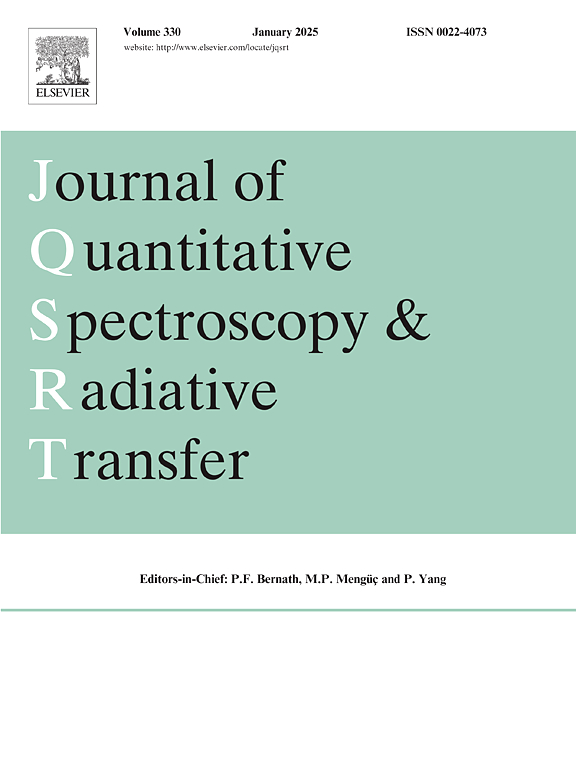MARVEL analysis of high-resolution rovibrational spectra of 17O13C18O and 17O13C17O
IF 2.3
3区 物理与天体物理
Q2 OPTICS
Journal of Quantitative Spectroscopy & Radiative Transfer
Pub Date : 2025-05-02
DOI:10.1016/j.jqsrt.2025.109485
引用次数: 0
Abstract
Spectroscopic networks, based on rovibrational line-center measurements found in 10/5 literature sources, are presented for the triply substituted carbon dioxide isotopologues / (738/737, according to a well-established shorthand notation followed in this study). For 738/737, the spectroscopic networks contain 2058(1488)/1831(1349) measured(unique) transitions, belonging to 25/22 vibrational bands. The transitions collected for 738 and 737 span the wavenumber regions and , respectively. These spectroscopic networks determine 945 and 877 empirical rovibrational energy levels for 738 and 737, respectively, extracted with the help of the MARVEL (Measured Active Rotational–Vibrational Energy Levels) protocol and code. The energy levels of 738/737 span the range of and the polyads from 0 to 11 for 738 and from 0 to 10 for 737. A detailed comparison of the empirical rovibrational energy levels of this study with their counterparts in two published databases, CDSD-296, and Ames-2021, shows very good overall agreement.
17O13C18O和17O13C17O的高分辨率旋转振动光谱的MARVEL分析
基于在10/5文献中发现的旋转振动线中心测量,给出了三取代二氧化碳同位素17O13C18O/17O13C17O(738/737,根据本研究中遵循的一种公认的速记符号)的光谱网络。对于738/737,光谱网络包含2058(1488)/1831(1349)个测量到的(独特)跃迁,属于25/22个振动带。738和737所收集的跃迁分别跨越了623 ~ 7888和624 ~ 6739cm−1的波数区域。这些光谱网络分别确定738和737的945和877经验旋转振动能级,并在MARVEL(测量的主动旋转振动能级)协议和代码的帮助下提取。738/737的能级范围为0 - 8762/0 - 7201hccm - 1, 738和737的多边形范围分别为0 - 11和0 - 10。将本研究的经验振动能级与两个已发表的数据库CDSD-296和Ames-2021中的相应数据进行详细比较,结果显示出非常好的总体一致性。
本文章由计算机程序翻译,如有差异,请以英文原文为准。
求助全文
约1分钟内获得全文
求助全文
来源期刊
CiteScore
5.30
自引率
21.70%
发文量
273
审稿时长
58 days
期刊介绍:
Papers with the following subject areas are suitable for publication in the Journal of Quantitative Spectroscopy and Radiative Transfer:
- Theoretical and experimental aspects of the spectra of atoms, molecules, ions, and plasmas.
- Spectral lineshape studies including models and computational algorithms.
- Atmospheric spectroscopy.
- Theoretical and experimental aspects of light scattering.
- Application of light scattering in particle characterization and remote sensing.
- Application of light scattering in biological sciences and medicine.
- Radiative transfer in absorbing, emitting, and scattering media.
- Radiative transfer in stochastic media.

 求助内容:
求助内容: 应助结果提醒方式:
应助结果提醒方式:


